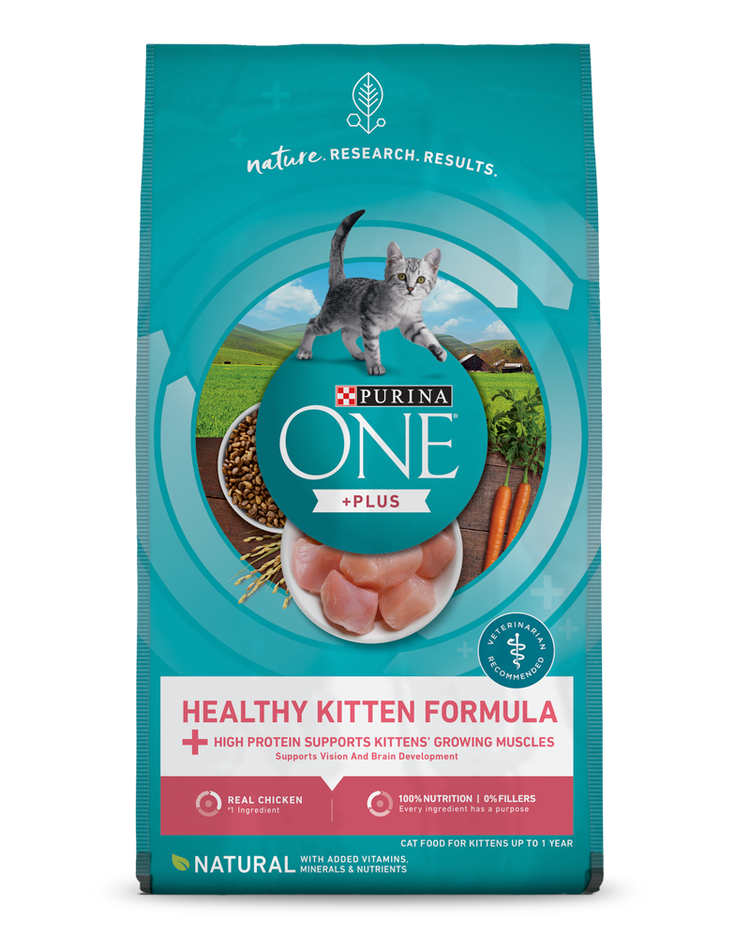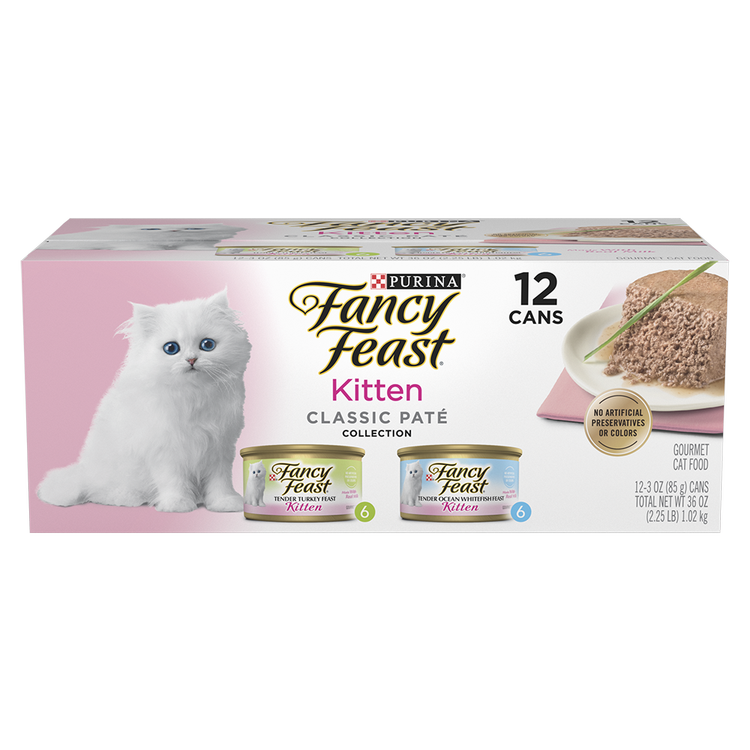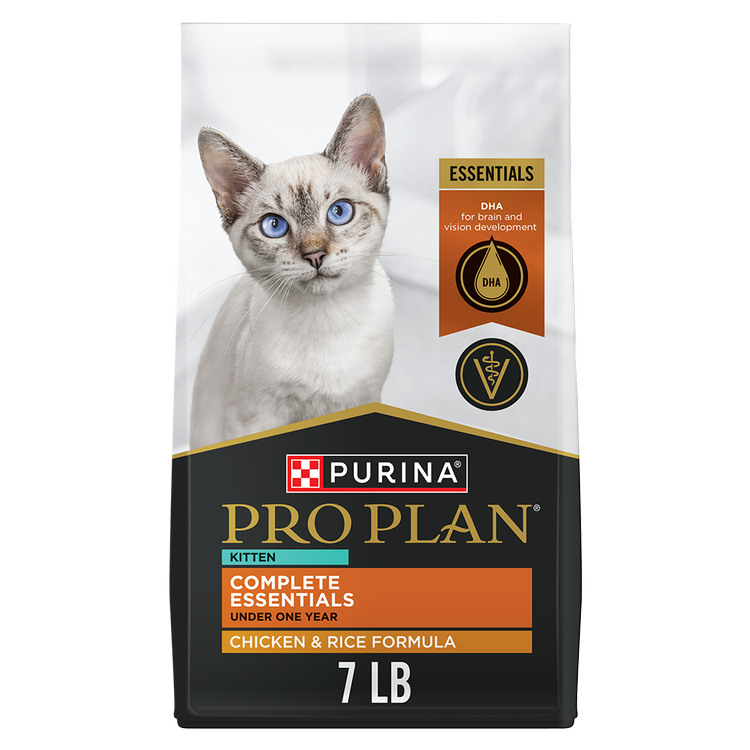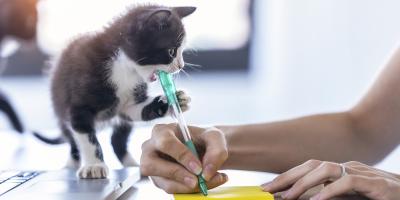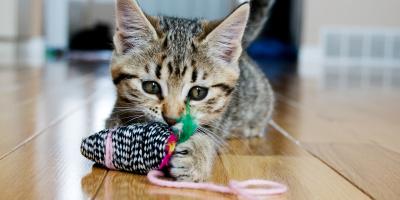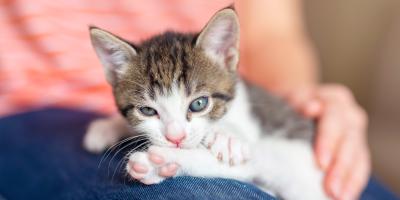How Much to Feed a Kitten: A Kitten Feeding Chart By Age

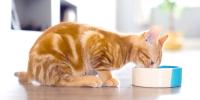
Choosing the right food for your kitten is an important decision. The proper nutrition supports her growth and development and can even affect her behavior. If you’re unsure, your vet can provide a recommended food for kittens.
The best food for kittens is a high-quality kitten food that will help support many long, healthy years as an adult cat. If you’re a first-time cat owner, learning the stages of kitten development, choosing the right food, knowing how much kittens eat, and knowing how often to feed a kitten can be a daunting task. We’ll help you understand the basics of kitten feeding to set you and your kitten up for success.
Kitten Nutritional Needs Change Over Time
Newborn kittens get their nutritional needs met from their mother through nursing. If you have neonatal kittens that have become separated from their mother, or if you notice one or more kittens from the litter losing weight or not getting enough milk from their mom, contact your vet about feeding with kitten formula.
Kittens without access to mother’s milk usually need to be fed every few hours, around the clock. Whether your kitten needs kitten formula as a substitute for mother’s milk or as a supplement, your vet can provide advice and an appropriate feeding schedule.
When can kittens start eating food? The weaning process usually begins when the kittens are around three to four weeks of age. At that age, the kittens may become interested in their mother’s solid cat food. When that happens, or at four weeks, separate the kittens from their mom for short bursts of time throughout the day. This will give mom a chance to rest and eat in peace and it provides an opportunity to introduce the kittens to solid food and help them become more independent.
To meet their unique growth and developmental needs, a kitten’s diet needs to be nutritionally complete and balanced. When it’s time for weaning, choose a protein-rich kitten food to support their growing bodies and provide the high energy they need. The kitten food should also include calcium to support strong teeth and bones, and DHA to help support healthy brain and vision development.
What Do Kittens Eat?
At what age can a kitten eat solid food? As kittens begin to wean, they can start to nibble (and play with) solid foods. So, what do you feed a kitten?
- After weaning, start with wet food or moistened dry kibble
- Over the next two weeks, gradually decrease water and increase food
- By 6 to 8 weeks, kittens can begin eating wet or dry food. Make sure that the wet or dry food is specifically formulated for kittens. Provide fresh, clean water every day
- Once a kitten has been completely weaned, they do not need milk in other forms
- Kittens reach adulthood at one year old and can switch to adult cat food at that age
How Much to Feed a Kitten
Now that you know what to feed your kitten, it’s time to discuss how much food kittens should eat. You’ll find a kitten feeding guide by age and weight on the pet food label that will tell you how much to feed your kitten.
You can usually find kitten feeding guides on kitten food packaging, but they don’t all look the same. Pay close attention to the chart on your kitten’s food label to ensure you’re feeding her the right amount based on her age and weight.
If you have more than one cat, make sure each one gets the amount they need. Some cats will gobble it all up, leaving nothing for the other cat!
You can also divide wet food into smaller portions and feed two-to-three times a day. If your kitten is eating wet and dry food, just make sure the total amount of food does not exceed the recommended daily serving. Any wet leftovers in her bowl should be discarded. You can store an open can of wet food in the refrigerator for up to 24 hours. Bring it up to room temperature before serving.
Use your kitten’s name when feeding to help her learn her name, while also associating you with a pleasant activity.
Here’s your kitten feeding chart for easy reference:
| Age (weeks) | Weight (lbs) | Daily Dry Kitten Food (8 oz cups) | OR | Daily Wet Kitten Food (3 oz cans) | Feeding Schedule | Feeding Tips |
|---|---|---|---|---|---|---|
| 4 to 12 | 1 to 3 | 1/4 to 1/2 cup moistened dry | OR | 1/2 to 1-1/2 cans | Divide into 3 to 4 meals per day | For kittens 3 to 4 weeks of age, keep moistened Pro Plan available at all times. At 6 to 8 weeks of age, kittens will normally eat dry or moistened food at will. If adding water, use no more than one part warm (not hot) water to three parts Pro Plan, changing frequently to ensure freshness. |
| 12 to 24 (3 to 5-1/2 months) | 3 to 5 | 1/3 to 2/3 cup dry | OR | 1-1/2 to 2 cans | Divide into 2 to 3 meals per day (dry food) Divide into 3 or more meals (wet food) | |
| 24 to 36 (5-1/2 to 8-1/4 months) | 5 to 7 | 1/3 to 2/3 cup dry | OR | 2 to 3 cans | Divide into 2 to 3 meals or at will (dry food) Divide into 3 or more meals (wet food) | If feeding both wet and dry food, feed a total of 4 to 8 ounces per day. |
| 36 to 52 (8-1/4 months to 1 year) | 5 to 14 | 1/4 to 3/4 cup dry | OR | 2 to 7 cans | Divide into 2 meals or at will (dry food) Divide into 3 or more meals (wet food) | If feeding both wet and dry food, feed a total of 3 to 8 ounces per day. As kittens near adulthood, their calorie needs may decrease. Continue to adjust the amount you feed to maintain your kitten in ideal body condition. |
| 52+ | 5 to 14 | 1/4 to 3/4 cup dry adult cat food | OR | 2 to 7, 3 oz cans of adult cat food | Divided into 2 meals or at will (dry food) Divide into 2 or more meals (wet food) | If feeding both wet and dry food, feed a total of 3 to 6 ounces per day. |
Please Note: This kitten feeding chart is based on Purina Pro Plan Development kitten formulas. Kitten feeding amounts vary from product to product based on calorie content and formula. Consult the feeding chart on the back of your kitten’s food packaging. Individual needs can vary, so consult with your veterinarian regarding special dietary needs.
The Best Kitten Feeding Schedule
Once you know what to feed your kitten and how much, it’s time to create a kitten feeding schedule that works for you both. Creating a routine and feeding her at the same time each day can help your kitten feel secure and will aid in forming a bond between you two that will last for many years to come.
How many times a day should a kitten eat? How often you should feed a kitten depends on her age. If you’re feeding dry kibble, divide your total daily amount into three-to-four servings until your kitten is four months old. After they reach 6 months of age, kittens can be fed once a day to three times or more. It depends on your schedule and your kitten’s habits, as long as you don’t give her more than her total daily calorie needs. For example, you can put dry kibble in her bowl in the morning and she can graze throughout the day. If a twice-a-day schedule works better, give half her daily amount in the morning and half in the evening.
Same for wet food or a combination of wet and dry food. Just make sure the wet and dry food combined meets the total amount of calories she needs in a day.
When Can a Kitten Eat Adult Cat Food?
Kittens grow fast, and before you know it, you’ll need to switch to adult cat food. For most cats, changing a kitten’s food should happen around her first birthday.
Your kitten’s first year goes by fast, but ensuring she’s getting the right nutrients during this time will help support her in the years to come.
How to Transition a Kitten to Cat Food
We recommend transitioning to adult food over the course of seven-to-ten days. This will help avoid any digestive upset as your cat gets used to her new food.
If your cat resists eating the new food, slow the transition and give her more time before you increase the amount of adult food. Consult your vet for additional tips on making the switch from kitten food to adult cat food or explore this article for information on transitioning to adult cat food.
Learning how much to feed a kitten is essential to giving your kitten a healthy start in life. With the tips in this article, and guidance provided by the feeding chart, you’ll be able to better provide the nourishment your kitten needs so that you can give her that start.
Calculate your Cat’s Perfect Portion
For more on kitten feeding and nutrition from our experts, visit our Pet Expertise page.

Find Your Pet’s Perfect Food
Get your personalized recommendation with our Pet Food Finder tool.

